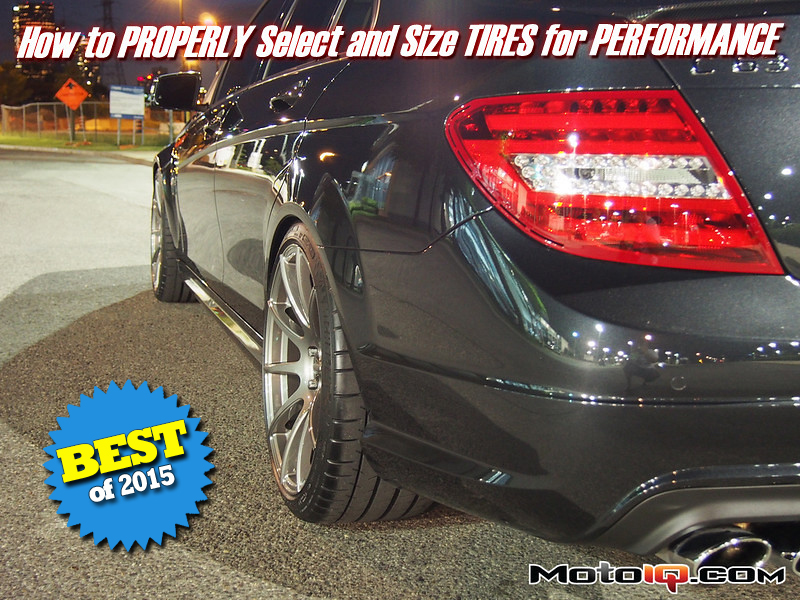How to PROPERLY select and size TIRES for PERFORMANCE
The most important part of your car is not the engine, suspension, or brakes. It’s the TIRES!!! This is because your car can only perform as well as the capability of its tires. I’m often asked which tire is best and what size to buy. In this article I discuss my methods for choosing and properly sizing the right tires. I’m not into the “hella-flush” or “stance” scenes so this article is focused towards those who care about the PERFORMANCE of their car, whether on the street or on the track.
Pirelli had the best slogan for a tire company: “Power is nothing without control.” This is true for all forms of driving since it does not matter how much power you have if you can’t put it to the ground, it doesn’t matter how much you spend on a big brake kit if they easily lock up the tires, and your $7,000 coilovers can only deliver the performance that your tires are capable of. It really does not matter how great and expensive your car is or how much money you’ve put into modifying it if you cheap out on tires; which is the only component on your car that actually touches the road.


Tires are consumable and expensive, but this should not be a justification for crippling the handling of your sports car, sports sedan, or minivan. Whether you’re trying to break records and win races on the track or simply avoiding an accident on the street, choosing the right tire will often dictate the success of either.
There are 3 main steps that I follow when looking for tires: CHOOSE A TIRE CATEGORY, SIZE THE TIRE, and SELECT A TIRE. SIZE & SELECT A WHEEL is my fourth and last step when also looking for new wheels.
STEP 1: CHOOSE A TIRE CATEGORY
“What is the car being used for?”
Buying the right tires for your grocery-getting, baby-hauling daily driver in the northeast or Florida (where it rains most days of the week) is going to be a lot different than buying tires for your weekend toy in Southern California that never sees rain. Determining the importance of dry, wet, snow performance, tire longevity, ride quality, and comfort should be the first step when looking for a tire.
Just like everything in life, choosing the best tire is often a compromise since it’s rare to find a tire that is really good in the rain, quiet and lasts a long time that can perform well in the dry and hold up to extensive track use. Usually as you increase the dry capability of a tire, you start to suffer wet performance and comfort in terms of noise and ride quality. However, in recent years a few manufacturers are starting to make tires that are very good in all categories.
TireRack.com is a great source of information for everything tire related. They have numerous customer reviews, independent tests, and are a pleasure to do business with. They break down tires into 5 main categories, while I added a 6th. These 5 main categories are further broken down into sub-sections like “Ultra High Performance”, “High Performance”, “Performance”, “Touring”, etc… I won’t go into detail since I usually pick tires from the top sub-section of every category. I have arbitrarily listed some examples for each category below:
2020 update – I don’t like what Tire Rack did to their categories so i’m sticking with their original categories below, and updating the list to add modern tires:
1.Winter/Snow:
Bridgestone Blizzak, Michelin Alpin, Continental ContiWinterContact, Pirelli Winter Snowcontol
2.All-Season:
Michelin Pilot Sport A/S 3, Continental ExtremeContact DWS, P Zero All-Season
3.Summer:
Michelin Pilot Super Sport & PS4S, Bridgestone Potenza RE070, Hankook R-S3, Dunlop ZII StarSpec, BFG Rival, Bridgestone RE-11, Pirelli P Zero Corsa System, Continental 5 & DW & SPORT
4.Streetable Track & Competition:
Michelin Pilot Sport Cup 2, Dunlop Sport Maxx Race 2*, Bridgestone RE-71R*, BF Goodrich G-Force Rival S/1.5*, Hankook Ventus TD, Hankook Ventus R-S4*, Continental ContiForceContact, Dunlop ZIII*, Falken Azenis RT660*, Firestone Firehawk Indy 500*, Yokohama AD08R*, Yokohama A052* (it’s more accurately in this category)
5. D.O.T. –Approved Slick AND Modern 2019+ *R-Compound Tires:.
Hoosier R7 & A7, BF Goodrich R1, Hankook Ventus Z214 – Michelin Cup 2 R*, Pirelli Trofeo R*, Goodyear Eagle F1 SuperCar 3R* – Nitto NT01, Toyo R888, Toyo R888R*, Yokohama A048,
6.Racing Slick:
Yokohama A005, Michelin, Hoosier, Pirelli
*Notice there is no “R-Compound” (“R” = Race Compound) tire definition in the above categories. “R-comp” is not really well defined other than the vague description of “race-derived rubber” and as a middle ground between street tires and racing slicks. This nomenclature is used for everything from the treaded NT01 and R888 to the slick A7, R7, and Ventus Z214. I prefer Tire Rack’s separation of the treaded “R-comps” into the Streetable Track & Competition category while placing tires with only circumferential grooves (like the Hoosier R7 & BFG R1) into the “D.O.T.-approved Slick” category. UPDATE: There is now a more prevalent use of “R-compound” tires from manufacturers like Michelin, Pirelli, and GoodYear that use motorsport “race” compounds in their “road” tires. I moved the commonly used “R-comp” track tires like NT01 & R888 to the DOT-approved slick section along with adding the tit’e “R-comp”. Many of the high performance ‘summer’ street tires (like the AD08R and Indy 500) are more in lines with the Cup 2 and Dunlop Race 2 tire than they are a PS4S or Conti Sport tire. I’m mostly considering the wet-weather performance in this re-categorization, but tire technology is getting better and blurring the lines between “summer” and “Streetable Track”.
UPDATE for 2020:
The categories have changed and are fairly jumbled up now. What use to be “Winter/Snow, All-Season, Performance Street, Streetable Track & Competition, DOT-approved Slick is now what you see below. Performance All-Season tires are now classified under the “Performance” category, so tires like the Pilot A/S 3 are now technically under category 3.
1.Winter/Snow (Studless Ice & Snow, Studded, Performance Winter):
Bridgestone Blizzak, Michelin Alpin, Continental ContiWinterContact, Pirelli Winter Snowcontol
2.Touring Tires (Grand Touring All-Season, Grand Touring Summer, Passenger All-Season):
Michelin Energy Saver, PremiumContact 6, Turanza ER30
3.Performance Tires (Extreme Performance Summer, Max Performance Summer, *UHP All-Season):
Michelin Pilot Super Sport & PS4S, Yokohama AD08R, Hankook R-S3, Dunlop ZII StarSpec, BFG Rival, Bridgestone RE-11, Pirelli P Zero Corsa System, Continental 5 & DW & DW SPORT, Bridgestone RE-71R*, BF Goodrich G-Force Rival S/1.5*, Hankook Ventus TD, Hankook Ventus R-S4*, Continental ContiForceContact, Dunlop ZIII*, Falken Azenis RT660*, Firestone Firehawk Indy 500*
Michelin Pilot Sport A/S 3, Continental ExtremeContact DWS, P Zero All-Season
4.Track & Competition (Racetrack & Autocross Only, Streetable Trak & Competition, Wet Racetrack & Autocross, Drag Racing):
Michelin Pilot Sport Cup 2, Dunlop Sport Maxx Race 2*, Michelin Cup 2 R*, Pirelli Trofeo R*, Goodyear Eagle F1 SuperCar 3R*, Hankook Ventus TD, Continental ContiForceContact, Nitto NT01, Toyo R888, Yokohama A048
5. All-Terrain Tires (On-/Off-Road All-Terrain, Off-Road Max Traction, On-/Off-Road Commercial Traction)
Mud-Terrain T/A KM2, Wrangler MT/R with Kevlar, Scorpion MTR, Open Country M/T
Here’s a Top Tip: “Tires are the most important. A narrower, but better (compound, construction, tread design, etc…) tire will, to a point, generally outperform a wider, inferior tire”.





25 comments
Thank you, very informative article!
Loved this article. But how do you calculate or optimize vehicle weight/hp to tire size?
Amazing article. Changes my whole perception of what i am looking for. 2017 mustang gt. Drop 1 inch, tiger grip wider. Staggered or not too. Like 275 on all 4 and do I look for height and 45s height compared to 50s height for stance
Glad to hear it helped.
Nice, but what’s the optimal weight to mm for tire width? I want a good compromise for street/weekend warrior use and looks on my 09 daily driven Scion tC. Don’t wanna take too much of a hit to mpg, but I want more room to soak up hard cornering and, as I said a more aggressive look.
Stock sizes are 215/45r17 and 225/40r18. I know a 235 will fit, and I’ve seen a couple of 245 and 255 fitments online, but it’s mostly 245 or below. Currently running BFG sport comp 2 a/s tires and like them. Live in Florida and was recommended those for my application. The car is FWD with a manual and 160hp, I intend to run a square setup.
Thanks for pointing out that choosing the right tires will be able to dictate the success of the race and also keep you safe from accidents. I will share this information with a friend of mine since he will be joining races once he gets his car customized. It has really been his goal to do so after being obsessed with a series of movies that focuses on this.
This is probably the best ‘layman’ article on tires I’ve read! Here’s why I’m here. 2018 Mustang GT, stock except exhaust, air box and multiple tunes including E85. Daily driver with track weekends. Stock rims are 18 x 7.5 rolling on Pirelli P Zero Nero P235/50ZR18. I want more grip in the rear. Don’t care to change wheel diameter bc Ford Engineers are smarter than I. Contemplating going to 10″ in rear with MT ET Street SS 285/40R18. Not married to them and am open to any suggestions you may offer. I’m interested in grip and of course a better ET.
Thank you for the kind words, it’s great to hear that feedback (which was the goal). To be honest, I’m not the best source for tire sizing when it comes to drag tires since I do not have firsthand experience testing how wheel widths affect longitudinal grip and launches of drag-specific tires.
What did you end up doing? Mine is a 2017 and trying get a better stance look with a drop 1 inch with a little wider tire,but my big concern is 40 45 or 50 height tires
Thanks for listing all the details which are of importance for proper tyre selection.
t
Yet, I did miss the part explaining the influence of “aspect-ratio”.
I actually trashed a set of all-weather tyres and damaged my rim, due to driving a bit to fast on a very poor rural road. Consequently, I searched for information regarding rally tyres on the web. Interestingly, the majority of rally tires of Michelin have aspect ratios of 60-65. Yet, these tyres have very stiff side-walls. What is your opinion regarding the influence of aspect ratio?
In addition, you mentioned that you consider load-index not to be be very useful. Yet, does load index influence the strength and stiffness of the side walls? Consequently, the higher the aspect ratio, the more important load index, especially using poor roads? Appreciate your view/
Mr. Johnson, your article is the most clearly explained writing I’ve found on the matter. Still it is not very clear for me what would happen to my 2019 Toyota Camry, with original 17″ x7.5 original wheels if I change original tire size of 215/55/17 to 235/55/17. My intention is to gain half an inch in underbody clearance, and of course any gain in performance would be wellcome. I appreciate any light you can give me on this matter.
Going from a 215/55 to a 235/55 would give you a tiny bit of ground clearance but would also change the circumference of the tyre, which may throw off your odometer and other systems. I suspect it’s not a good idea, if you want more ground clearance the proper way to do it is to install adjustable coil-over suspension.
The wider tire will lose steering response and feel more vague and ‘mushy’ as the sidewall deflects more before loading up. Peak grip will likely increase. I’m not sure you’ll gain 0.5″ in ride height from making that switch. Check out a tire size calculator to be sure.
Than you for writing this article! It is very informative! What I did miss was information on what would be a balanced mm/Lb for track use. You present a table with multiple vehicles, but do not comment on whether you find those values too high or too low, with the exception of the Elise, that isn’t even on the table. What would be a good range for mm/Lb?
It depends on the tire. Whatever it takes to keep a tire in its ideal operating temperature window is what should be targeted.
First of all, excellent article, i appreciate the time and effort placed into explaining all the nuances of selecting a damn tire. Ive already screen shotted some portions for my digital “Car” notes.
I just have one critique from a data driven, engineering minded geek.
In the TTSA chart, TTSA seems to be calculated only using half of the tires….1xFront+ 1xRear… thats not total…I realize that may not be your chart, but when i come across calculations like these that aren’t completely logical, it makes me ask…why? In the end, i know it will just change those numbers by a factor by 2, but to me it makes more sense to use the TTSA that uses all four tires. Of course, if there is an industry standard that uses 1xFront and 1x Rear, then so be it; i am ignorant to it (alibi: i am new to this game)
Once again, thanks for making your experience available for the entire world to learn.
Cheers!
Haha, thanks. As far as TTSA goes, feel free to multiply all the numbers by 2. For comparisons sake, only looking at half the tires does not affect the results.
That was very helpful, thanks. On my Lotus Elise S1 (1800lbs), I’ve always found that I could not get heat into my tires (205F/245R). For many years I was following the ‘wider is better’ gang. But this year I’ve decided to try a smaller size (195 & 225). I’ll be saving weight and hopefully heat them faster too! Over the time I’ve also came up with the thinking of choosing a tire first then get the wheels. Thanks for the great article !
Glad to hear it. The #1 thing is the compound of the tire and keeping it in it’s operating temperature range.
Good article but the information I’m looking for doesn’t get addressed.
How do I choose tyre sizes for my car based on power and weight?
My car weights 550kg and has rear wheel 60bhp
I currently have 13×7″ rims wearing 195 section tyres.
I’m sure that’s too much rubber.
Should I get narrower rims and save weight or would this cause a lack of traction?
It depends on what your goals and objectives are, if you’re limited by a certain UTQG or ‘class’ of tire, and once you determine what tire you’re going to run, then you would need to look at your tire temps. If you’re overheating your 13×7″ 195 tires, then you will likely improve grip and laptimes by going with wider tires. If you are not getting your tire up to peak operating temperature, then going down on tire size will put more energy into the tire, and get the operating temps higher where the tire will make more grip. So it depends on your current setup and data.
Great article! But just want some clarification when you refer to wheel width are you referring to the width of bead seat to bead seat or the overall wheel width?
I’m so glad I found your article somewhat randomly while trying to understand which “load index” to select. You gave me a set of completely new dimensions to look for and especially to match wheel width and tire width. Spot checking shows that most 275/35R18 track focused tires i was tentatively loooking at are too wide for 9.5″ rims. Thank you!
I think your TTSA and weight ratios comparison chart is wrong. All of the numbers in the mm/lb column are half what they should be. The TTSA used is only for one tire per axle, meaning the TTSA is doubled, halving the mm/lb column.
Take the third example of the Dodge Viper, a 295/25R19 front. That’s a tire circumference of 1,980 mm x the 295 width, I get 584,100 but I don’t know the actual tread width, so close enough for this to your 587,451. That however is one tire, for both front we must double it to 1,174,902 for the front total.
Do the same with the rear and we get a rear total of 1,550,924, add front and rear together for 2,725,826. This should be the number in the TTSA column, not 1,362,913. This means the mm/LB goes from 413 to 826.
Hello, planning a time attack build. Been looking at multiple sources and fitment industries was saying to add an inch to listed wheel widths as typically the bead width and not the full width is listed. I know you’re saying to mark a half inch up for better handling. Just wondering your thoughts on what wheel width to go off of to hit this mark, thanks.